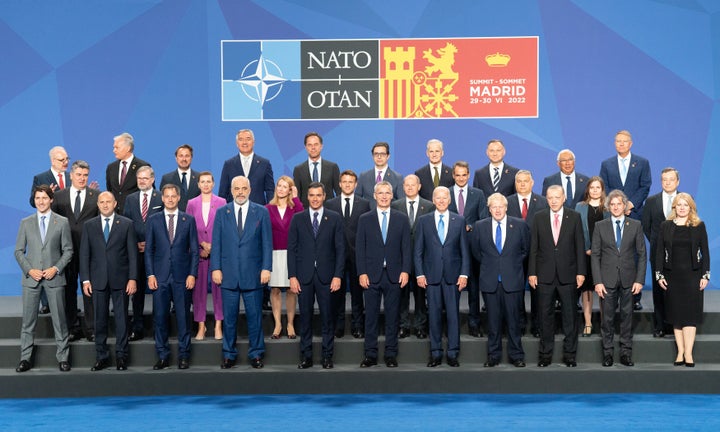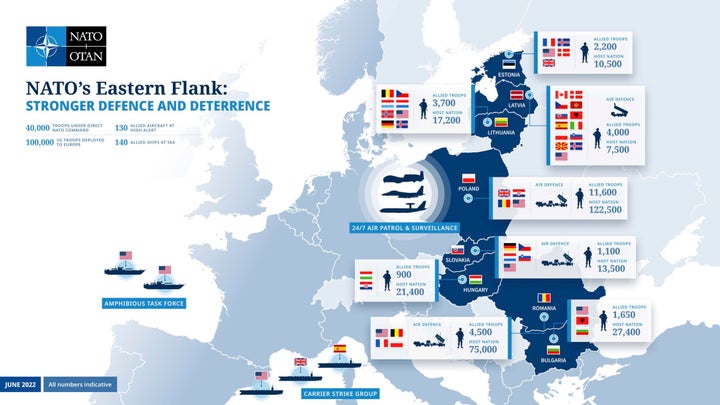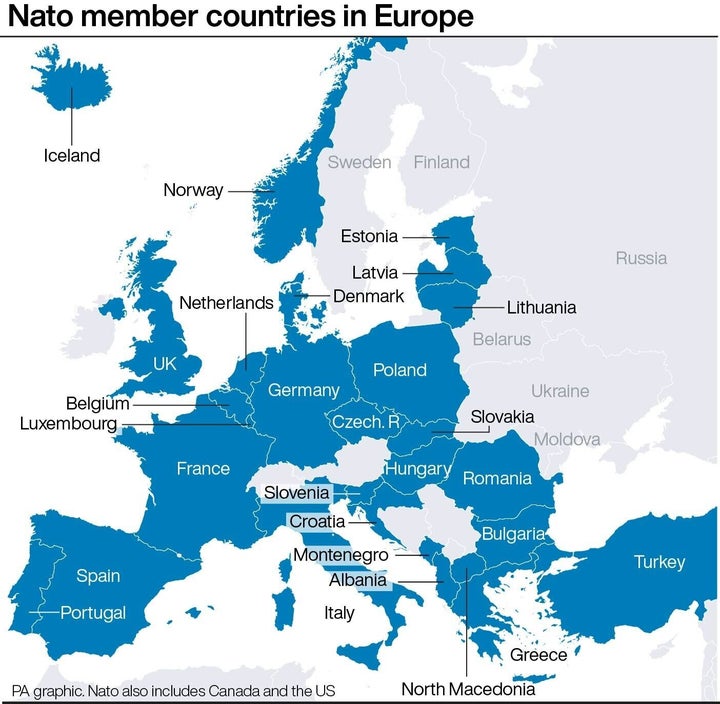
British front pages on Thursday feature stories about Nato’s proposed response to Russia’s growing threat and the advent of “Europe’s new Iron Curtain” – a reference to a return to Cold War-era tensions.
At the summit of 30 member nations in Madrid, the organisation committed to the biggest strengthening of its deterrents since the 1980s in response to the invasion of Ukraine.
The US-led North Atlantic Treaty Organisation – or Nato – was formed in 1949 to prevent a resurgence of nationalism and militarism in Europe after two world wars, and to deter the Soviet Union’s expansion.
Its membership swelled over the 1990s and 2000s as its enlargement stretched further east to include the former Soviet republics of Estonia, Latvia and Lithuania.
The Iron Curtain described the hard borders between eastern Europe and the rest of the continent during the Cold War, and a series of developments on Wednesday prompted a revival of the phrase as an effective blockade from the Black Sea up to the Baltics emerged.
1. US commits to 100,000 troops being stationed in eastern Europe.
US president Joe Biden announced a dramatic shift. The US said it is prepared to keep 100,000 troops in Europe for the “foreseeable future” – up from 80,000 before the war in Ukraine began.
Among the changes will be a permanent US garrison in Poland, for the first time creating an enduring American foothold on Nato’s eastern flank.
“We mean it when we say an attack against one is an attack against all,” Biden said, referring to the Article 5 of the Nato constitution, which agree to mutual defence – military action – in response to an enemy attack.
Biden also said the US would step up its temporary deployments of troops to Romania and the Baltic region.
The expanding US military presence is still far short of its numbers during the Cold War, when roughly 300,000 American troops, on average, were stationed in the region.
2. Other US interventions
The president also said the US would send two additional squadrons of F-35 fighter jets to the UK, and air defence systems will be built in Germany and Italy.
Biden announced on Tuesday after arriving for the summit that the US would base two additional destroyers at its naval base in Rota, Spain, bringing the total number to six.
The US announcement is bolstered by other commitments made by allies on the continent, with Germany and Britain putting troops on alert to deploy eastward.

3. New official position towards Russia
The Times reported that Nato member nations have agreed a “new strategic concept” as a blueprint to set out the alliance’s goals for the next decade.
Russia was described as “the most significant and direct threat to allies’ security and to peace and stability in the Euro-Atlantic area”. In the previous concept agreed in 2010, Russia was described as a “strategic partner”.
Nato plans to increase the size of its rapid reaction force from 40,000 to 300,000 troops by next year. Although the troops would be based in their home countries, they would be ready to deploy further east, where the alliance will stockpile equipment and ammunition.
4. Finland and Sweden close to Nato membership
Nato’s leaders formally invited Finland and Sweden into the alliance, a decision that once ratified would end decades of Nordic neutrality by putting the two countries under the US-led nuclear umbrella.
“The significance of this really can’t be overstated,” British prime minister Boris Johnson told reporters. “We’re seeing the expansion of the alliance, which is exactly the opposite of what Putin wanted. He wanted less Nato, he’s getting more.”

It comes as Turkey dropped its veto against the two countries’ path to membership. As part of the deal, Sweden and Finland agreed not to support Kurdish militant groups.
Both Finland, which has an 810-mile border with Russia, and Sweden are now set to bring well-trained militaries into the alliance, possibly giving Nato Baltic Sea superiority.
5. UK promises extra £1 billion for Ukraine
The UK will provide an extra £1 billion of military aid for Ukraine, dramatically increasing its support for Volodymyr Zelensky’s defence of his country.
The new funding amounts to a 77% increase on the £1.3 billion already provided, with Johnson claiming British support was “transforming Ukraine’s defences” against the Russian onslaught.
The UK promised funding towards capabilities including sophisticated air defence systems, drones and electronic warfare equipment.
British officials said the equipment represents the first step in enabling Ukraine to go beyond defence and carry out offensive operations against Russian ground forces in order to recover lost territory.
